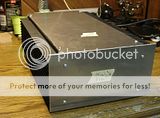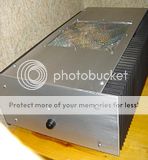Having, maybe, finally, "finished" by 1st DIY SS Class A amp I have a few questions, observations concerning interior box heat...
I built my mini-A case out of scrap & the way it seemed a lot of others do; using the side heatsinks structurally. IOW, there are 6 total pieces to the case, with top/bottom/front/back directly & tightly attached to the heatsinks top & bottoms. Looked like this before completion:

There was a 1/2" gap between bottom (front) & face and between back (top) & top.
And all the non-heatsink pieces drew off heatsink heat (of course) and the entire structure got "as hot as a box in a forest fire".
I've since drilled several 1/2" holes in the bottom & back panels and hacked a big hole in the top. This releases lots of heat so I'm o.k. with this even tho it's a bit ugly.

To the question; How are others managing this?
I've seen a few say that they operate their amps with the top off completely.
I'm thinking for my next build that I'd thermally isolate (somewhat) the heatsink(s) from the case pieces....
Like by providing .1" - .2" air space clear around the heatsinks (spacers) where they would have contacted the sides & top directly.
I've looked through some galleries, etc. & it sure looks like the aluminum shells are in direct contact with the heatsinks & I'd think the entire structure becomes an oven (unless there a whole lot of air holes I'm not seeing).
(unless there a whole lot of air holes I'm not seeing).
I built my mini-A case out of scrap & the way it seemed a lot of others do; using the side heatsinks structurally. IOW, there are 6 total pieces to the case, with top/bottom/front/back directly & tightly attached to the heatsinks top & bottoms. Looked like this before completion:

There was a 1/2" gap between bottom (front) & face and between back (top) & top.
And all the non-heatsink pieces drew off heatsink heat (of course) and the entire structure got "as hot as a box in a forest fire".
I've since drilled several 1/2" holes in the bottom & back panels and hacked a big hole in the top. This releases lots of heat so I'm o.k. with this even tho it's a bit ugly.

To the question; How are others managing this?
I've seen a few say that they operate their amps with the top off completely.
I'm thinking for my next build that I'd thermally isolate (somewhat) the heatsink(s) from the case pieces....
Like by providing .1" - .2" air space clear around the heatsinks (spacers) where they would have contacted the sides & top directly.
I've looked through some galleries, etc. & it sure looks like the aluminum shells are in direct contact with the heatsinks & I'd think the entire structure becomes an oven
 (unless there a whole lot of air holes I'm not seeing).
(unless there a whole lot of air holes I'm not seeing).cfcubed said:....and the entire structure got "as hot as a box in a forest fire".
The original Alephs worked tirelessly this way; mine for >10 years now. Every part of the structure is a heatsink. If you look closely at an Aleph you'll see a full length gap at the corners where the heatsinks meet.
She's hot and so sweet...
Re: Re: Coping with amp box heat (not heatsink sizing)
True, all it takes is ADEQUATE heatsinking. That electronics are working at 45C ambient is no problem at all.
Magura
Blues said:
The original Alephs worked tirelessly this way; mine for >10 years now. Every part of the structure is a heatsink. If you look closely at an Aleph you'll see a full length gap at the corners where the heatsinks meet.
She's hot and so sweet...
True, all it takes is ADEQUATE heatsinking. That electronics are working at 45C ambient is no problem at all.
Magura
I just want to say, I always leave good airflow to the electronics. I think it helps draw air to the heatsink fins surrounding them. But the inside heatsink surface is surface too! It wll lower the thermal R if it has airflow. And, it certainly can lower the component temps greatly.
I once heard that IBM did testing to determine air flow characteristics but uncovered some important other info. If you use a woven screen type material, or a perferated sheet, for ventilation and flow, the most sufficient, but most safe max is about 1/4 inch (6.35mm) weave or holes. This allows airflow but this dimension will choke flames from passing through. A consideration I think worth considering
My problem is ussually finishing the irregular edge you enevitably get
I once heard that IBM did testing to determine air flow characteristics but uncovered some important other info. If you use a woven screen type material, or a perferated sheet, for ventilation and flow, the most sufficient, but most safe max is about 1/4 inch (6.35mm) weave or holes. This allows airflow but this dimension will choke flames from passing through. A consideration I think worth considering
My problem is ussually finishing the irregular edge you enevitably get
Re: Re: Re: Coping with amp box heat (not heatsink sizing)
Yes, right now my sinks are between 'crikey hot' & 'bloody hot' (3 or 4 secs hands-on, low 50s deg C on my grill thermometer . Thinking my heat sinking is adequate that this is just the way things are around these parts.
. Thinking my heat sinking is adequate that this is just the way things are around these parts.
Me too, from PC building days always watching that on GPUs, CPUs, HDs, etc. I suppose sticking w/105c caps & having some air flow should do.
Thanks guys. I guess I have to worry less & enjoy the music more.. As long as it doesn't cost me another pair of FE126s like my tube pre offset did
True, all it takes is ADEQUATE heatsinking. That electronics are working at 45C ambient is no problem at all.
Yes, right now my sinks are between 'crikey hot' & 'bloody hot' (3 or 4 secs hands-on, low 50s deg C on my grill thermometer
Originally posted by flg
I always leave good airflow to the electronics.
Me too, from PC building days always watching that on GPUs, CPUs, HDs, etc. I suppose sticking w/105c caps & having some air flow should do.
Thanks guys. I guess I have to worry less & enjoy the music more.. As long as it doesn't cost me another pair of FE126s like my tube pre offset did

I have a series of holes about 1.5" in diameter all along the length of each heat sink and around the transformer. Similar holes along the top. Use taller rather than shorter feet for the amp. The combo of the spacing off the amps surface and the holes will promote good convection inside the chassis.
If I place my hand over the heat sinks or vent holes, I can feel the flow of air by convection.
My chassis has a 5" low speed (low noise) fan in the rear to pull air out of the chassis and in through the vent holes. I've never hooked it up, haven't needed to so far. I was going to connect the fan to a thermal switch to only kick on above a certain threshold temperature.
-David
If I place my hand over the heat sinks or vent holes, I can feel the flow of air by convection.
My chassis has a 5" low speed (low noise) fan in the rear to pull air out of the chassis and in through the vent holes. I've never hooked it up, haven't needed to so far. I was going to connect the fan to a thermal switch to only kick on above a certain threshold temperature.
-David
- Status
- This old topic is closed. If you want to reopen this topic, contact a moderator using the "Report Post" button.